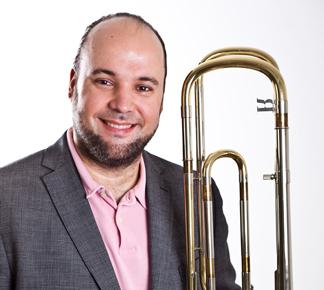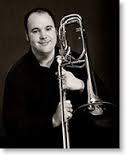Many of the early instrumental solo virtuosi, (usually violinists or keyboardists), eventually secured lasting fame as composers first, and virtuosi second. Before sound recording, composition was the surest way for the early virtuoso to secure more enduring recognition. Perhaps the two virtuosi who cast the longest shadows of influence into the Romantic and Modern eras as both players and composers were the violinist Niccolo Paganini and the wizard of the piano, Franz Liszt. For many Hungarian musicians in particular and those trained in Hungary, the soloist Liszt looms larger than life as a national treasure, musical icon and inspiration. Amidst this backdrop has emerged a bass trombonist who is consumed with pursuing the full virtuosic potential of the classical bass trombone as as a solo instrument. Matyas Veer, recently appointed to the Netherlands Philharmonic possesses an impressive momentum as a video recording artist on the bass trombone. Combined with his orchestral experiences, and a passion for the trombone quartet, he is a vital force and video pioneer in advocating the soloistic use of the bass trombone. Matyas will be joining Ben van Dijk, Denson Paul Pollard and Erik Van Lier as a faculty member for the upcoming Dutch Bass Trombone Open. “Seven Positions” is delighted to host Mr. Veer as the fifth respondent of our third series of “7 Poositions” tm.
 1. What do you look for in an instrument?
1. What do you look for in an instrument?
The key is the ease of operation and a good sound. Since I first began playing the trombone I have been sensitive to the mechanical condition of my instrument. The slide (including tuning slides), and valves always had to fit perfectly-these are the basics. Of the instruments presently available, I prefer Michael Rath’s trombones. I prefer a dual bore slide with Hagmann or Thayer valves. The size and material of the bell can affect the tone, but in reality, the sound depends on the breathing and technique of the player.
 2. How do you conceive, describe or visualize the ideal tone quality?
2. How do you conceive, describe or visualize the ideal tone quality?
The sound should be thick and glossy, but mainly centered. Since I played tenor trombone for a very long time, so I prefer a lighter bass trombone sound, and this suits the performance of the solo pieces as well.
In my opinion the bass trombone is clearly part of the trombone section, and not a member of the tuba section.
Of course, maintaining a good balance with the tuba is important too, but if we look that the second trombone is the bridge,than the first trombone and the bass trombone have to be the bridge pillar. Some exceptions to this include the works of Russian composers, where the bass trombone works in parallel with the tuba. In these instances, the tone ought to become darker.
3. What is your secret to a good legato?
The secret of a good legato is most influenced by breathing techniques and hand motions.
The air flow should be trained with vocally oriented literature such as etudes as cantilenas.
The slide should never be allowed to be handled in a lazy way, and special care should be taken to execute glissando.
4. What helps you to achieve musical expression?
It is succumbing to the fantasy that solves everything. Find the goal inside yourself, and work it out precisely-110%. Be serious in what you are doing!
5. Name two types of inspiration: Musical & Non-musical
Musically: to take part in such a completely absorbing musical performance, is euphoric in itself. Concentration and maximum focus, allows perfect playing, in the end, happiness.
It is my goal to be able to inspire musicians, and not only trombone players. As a result, my ideal of beauty is is the violin and the voice are very close to my heart-perhaps Placido Domingo or Itzhak Perlmann.
Non-musical: My inspiration is my family.
6. How did you begin to develop as a soloist?
It started it very early. As a musician in a family of musicians, my whole family has always been natural on stage. Around the age of 10, besides playing the trombone, I also sang in the Hungarian State Opera Children Choir. I was on stage at least 5-10 times per month.
In Hungary “brass soloists†are carefully trained, and this means that there is an even greater emphasis on the solo repertoire than on the orchestral literature. During my studies, it was my goal to be a participant in solo competitions. These training I received has formed the basis of my development as well. The concerts and competitions with the Corpus Trombone Quartet helped as well.
Please discuss your favorite solos on bass trombone
My favorite piece? This is an unanswerable question. The piece which I actually working out, it is the dream of the moment, and it will become my favorite.
7. When playing really soft (ppp), becomes necessary what percentage does each contribute to the equation? The right equipment/Air flow/Embouchure Control/Other
I think the instrument has little to do with the creation of the “pianissimo”. The best role the trombone can provide is what I have already mentioned-perfect technical condition. It seems to me that the air matters most. Only a fully relaxed, stress-free breath can produce an effective piano. The lips must stand in facing forward position, so that the lips and slide should be ready for action in order to respond to the relaxed breath. Just like the performance of an athlete,
fine pianissimo playing can’t rely only on talent. We have to prepare mentally and physically as well.
T1. What is the best trombone playing you have ever heard?
The two bass trombone players who have made the biggest impression on me are Ben Van Dijk and Csaba Wagner.
I was only 13 years old when I first heard Ben and I loved it!
Csaba is my best friend and we grew up together. What he is doing with the trombone, has alays been exemplary for me.
My favorite contrabass trombonist is the amazing Brandt Attema.
The tenor players and jazz trombonist I like are Christian Lindberg, Michel Becquet, Joe Alessi, and Wycliff Gordon..It is impossible for me to single out only one name, because I admire and enjoy listening to all of them.
T2. What is the best trombone playing you have ever done?
The best thing I’ve played? Good question. The key is the audience. I’m so gratified when I am able to connect with a great number of people through my playing. When people are happy and I have had a part in sharing this happiness with them through my music-that is all that matters to me. That is the most important feeling: to play something that people like.
T3. What does an opportunity of focusing exclusively on the bass trombone (without tenor trombone, tuba or any other instrument), such as the opportunity found at the DBTO reveal?
The DBTO is vitally important because it represents the essence of the bass trombone: real bass trombonist teaching real bass trombonists. I always dreamed of participating in festivals like this when I was younger.
The DBTO is a fantastic opportunity for every bass trombonist!
Interested in more “Seven Positions†tm Interviews?
Charlie Vernon
James Markey
Chris Brubeck
Doug Yeo
Jeremy Morrow
Tom Everett
Gerry Pagano
Ben van Dijk
Randall Hawes
Denson Paul Pollard
Thomas Matta
Fred Sturm
Bill Reichenbach
Massimo Pirone
Erik Van Lier
Jennifer Wharton
Matyas Veer
Stefan Schulz
c. 2014 David William Brubeck All Rights Reserved davidbrubeck.com
images courtesy of DBTO, and Matyas Veer
Interested in more “Seven Positions†tm Interviews?
Charlie Vernon
James Markey
Chris Brubeck
Doug Yeo
Jeremy Morrow
Tom Everett
Gerry Pagano
Ben van Dijk
Randall Hawes
Denson Paul Pollard
Thomas Matta
Fred Sturm
Bill Reichenbach
Massimo Pirone
Erik Van Lier
Jennifer Wharton
Matyas Veer
Stefan Schulz
c. 2013/2014 David William Brubeck All Rights Reserved davidbrubeck.com
